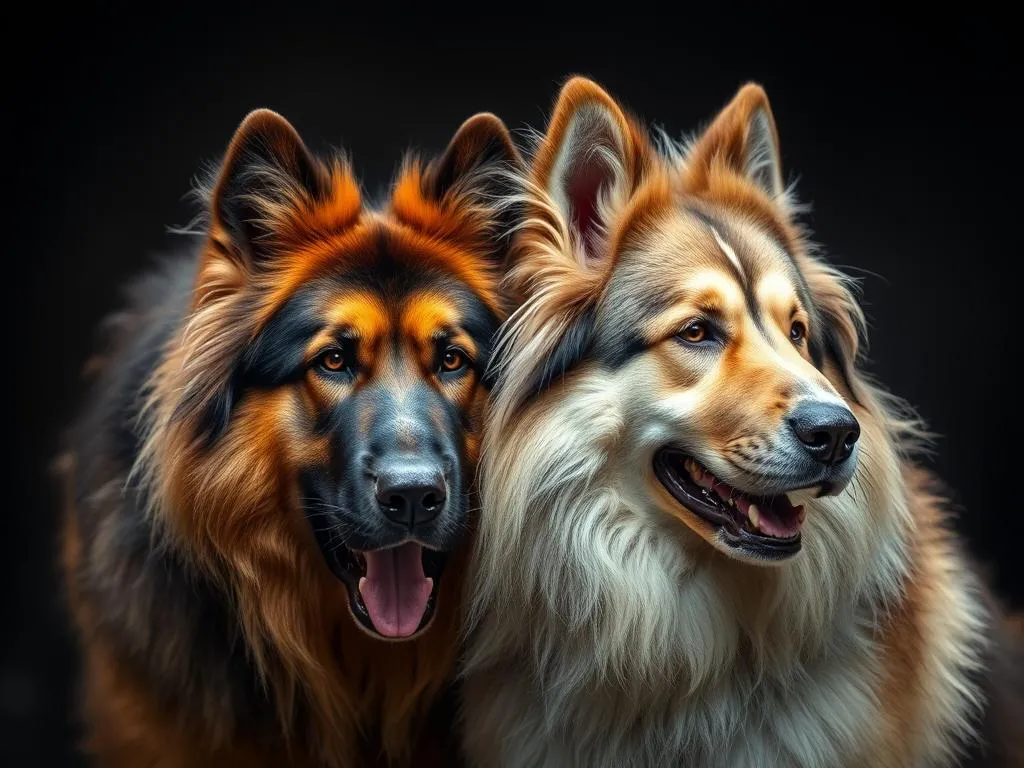
Large dog breeds are increasingly popular among dog lovers, admired for their imposing presence and loyalty. Among these breeds, the Caucasian Shepherd and Tibetan Mastiff stand out due to their unique characteristics and historical significance. Understanding the differences and similarities between these two breeds is crucial for potential owners, as each breed has its own set of traits that may suit different lifestyles. This article will delve into various aspects of both breeds, providing a clear comparative analysis.
Breed Origins
Caucasian Shepherd
The Caucasian Shepherd, also known as the Caucasian Ovcharka, has a rich historical background that stretches back centuries. Originating from the Caucasus region, this breed was primarily developed for guarding livestock against predators such as wolves and bears. The harsh mountainous terrain and extreme weather conditions of the region contributed to the dog’s robust build and protective instincts. The Caucasian Shepherd’s history is intertwined with that of various pastoral communities, where it served not only as a protector but also as a companion.
Tibetan Mastiff
In contrast, the Tibetan Mastiff hails from the high altitudes of Tibet. This breed was historically used by nomadic cultures to protect their livestock and monasteries from wild animals and intruders. Known for their strength and courage, Tibetan Mastiffs have been revered by Tibetan cultures for centuries. The breed’s origins are steeped in spirituality, often associated with the guarding of sacred sites. The Tibetan Mastiff’s imposing size and thick coat are adaptations to the harsh Himalayan climate, making them well-suited for their protective roles.
Physical Characteristics
Size and Weight
When comparing the Caucasian Shepherd and Tibetan Mastiff, size is one of the most noticeable differences.
-
Caucasian Shepherd: Males typically weigh between 110 to 220 pounds and stand 25 to 30 inches tall at the shoulder. Females are slightly smaller, averaging 80 to 180 pounds and standing 24 to 28 inches tall.
-
Tibetan Mastiff: Males generally weigh between 90 to 150 pounds, with a height of 26 to 30 inches. Females are usually a bit lighter, weighing between 70 to 120 pounds and standing 24 to 28 inches tall.
Coat and Color
Both breeds have distinct coats that serve protective functions, but they differ in texture and maintenance.
-
Caucasian Shepherd: This breed features a thick double coat that can be either long or short, with a coarse outer layer and a soft undercoat. Common colors include gray, cream, fawn, and brindle, often with a mix of these shades.
-
Tibetan Mastiff: Similarly, Tibetan Mastiffs have a heavy double coat that is long and dense, providing insulation against cold weather. Their color variations include black, brown, gray, and gold, often with tan markings.
Distinctive Features
Distinctive physical traits help differentiate the two breeds:
- The Caucasian Shepherd has a broad head, a strong neck, and a powerful build, often with a more pronounced jaw structure.
- The Tibetan Mastiff possesses a lion-like mane around its neck and a slightly more refined facial structure, giving it an air of nobility.
Temperament and Behavior
Caucasian Shepherd Temperament
The Caucasian Shepherd is known for its strong-willed and assertive nature. These dogs are fiercely loyal to their families and can be very protective. They are generally good with children, often forming strong bonds with them, but socialization is crucial to ensure they are well-adjusted. Their protective instincts can make them wary of strangers, which can result in a need for consistent training and social exposure from an early age.
Tibetan Mastiff Temperament
In comparison, the Tibetan Mastiff exhibits a more aloof and independent temperament. While they are also protective and loyal, they tend to be more reserved around strangers. Tibetan Mastiffs can be playful and affectionate with family members, including children, but their independent nature can sometimes lead to stubbornness. Early training and socialization are essential to manage their protective tendencies effectively.
Comparison of Temperament
While both breeds share protective instincts and loyalty, their temperaments differ notably. The Caucasian Shepherd is more assertive, while the Tibetan Mastiff tends to be more independent. This difference can impact training approaches; Caucasian Shepherds may require firmer handling, whereas Tibetan Mastiffs may need a gentler, more patient approach.
Training and Exercise Needs
Training the Caucasian Shepherd
Training a Caucasian Shepherd can be challenging due to their strong-willed nature. They require an experienced owner who can provide consistent, firm, and positive reinforcement training. Early socialization and obedience training are vital to help them understand their role within the family and to manage their protective instincts.
Training the Tibetan Mastiff
The Tibetan Mastiff can also be a challenge to train but often responds better to positive reinforcement methods. Their independent nature means that they might not always be eager to please, making patience a key component in training. Like the Caucasian Shepherd, early socialization is crucial for a well-rounded temperament.
Exercise Requirements
Both breeds need regular exercise to maintain their physical and mental well-being:
-
Caucasian Shepherd: Requires at least 60 minutes of exercise daily, which can include walks, playtime, and mental challenges like obedience training.
-
Tibetan Mastiff: Needs around 30 to 60 minutes of daily exercise. Activities can include walks, playtime, and interactive toys to keep their minds stimulated.
Health and Lifespan
Common Health Issues
Both breeds are generally healthy, but they can be prone to specific health issues:
-
Caucasian Shepherd: Common health problems include hip dysplasia, elbow dysplasia, and certain heart conditions.
-
Tibetan Mastiff: This breed may face issues such as hip dysplasia, hypothyroidism, and certain skin conditions.
Lifespan
-
Caucasian Shepherd: The average lifespan ranges from 10 to 12 years.
-
Tibetan Mastiff: They typically live between 10 to 14 years, making them one of the longer-living large breeds.
Preventative Care
Regular veterinary check-ups, vaccinations, and screenings for both breeds are essential to monitor their health and prevent common issues. A balanced diet and proper exercise will also contribute to their overall well-being.
Living Conditions and Suitability
Ideal Living Environment
When considering the Caucasian Shepherd and Tibetan Mastiff, understanding their living conditions is crucial:
-
Caucasian Shepherd: They need ample space to roam and exercise, making them suitable for homes with large yards or rural settings.
-
Tibetan Mastiff: While they can adapt to various living situations, they do best in homes with sufficient space for exercise and activities.
Compatibility with Families
Both breeds can be excellent companions for families, but potential owners should consider their experience levels:
-
Caucasian Shepherd: Suitable for families with older children and experienced dog owners who can provide consistent training.
-
Tibetan Mastiff: They can be good with children but may not be the best choice for first-time dog owners due to their independent nature.
Climate Considerations
Both breeds are well-suited to colder climates due to their thick coats. However, they can adapt to different environments with proper care. Owners in warmer climates must ensure that their dogs have access to shade and water to prevent overheating.
Cost and Maintenance
Initial Purchase Price
The initial cost of acquiring either breed can vary significantly based on factors like location and breeder reputation:
-
Caucasian Shepherd: Prices can range from $1,000 to $2,500.
-
Tibetan Mastiff: This breed often comes with a higher price tag, usually between $2,500 and $5,000.
Ongoing Expenses
Ongoing expenses for both breeds include food, grooming, and healthcare:
-
Caucasian Shepherd: Expect to spend around $70 to $100 monthly on food, plus additional costs for grooming and veterinary care.
-
Tibetan Mastiff: Monthly food expenses can range from $80 to $120, with similar grooming and healthcare costs.
Grooming Needs
Both breeds require regular grooming due to their thick coats:
-
Caucasian Shepherd: They need brushing at least once a week, increasing to several times a week during shedding seasons.
-
Tibetan Mastiff: Regular brushing is also necessary, typically once or twice a week, with more frequent grooming during shedding periods.
Conclusion
In summary, the Caucasian Shepherd and Tibetan Mastiff are both magnificent breeds with distinct characteristics that make them unique. While they share similarities in size and protective instincts, their temperaments, training needs, and living conditions can vary significantly. Potential owners should carefully consider their lifestyle, experience level, and the specific traits of each breed to make an informed decision.
Choosing the right breed is a commitment that should align with individual preferences and circumstances. Both breeds can offer loyalty and companionship but require dedicated owners who can provide the love, training, and care they need to thrive.









